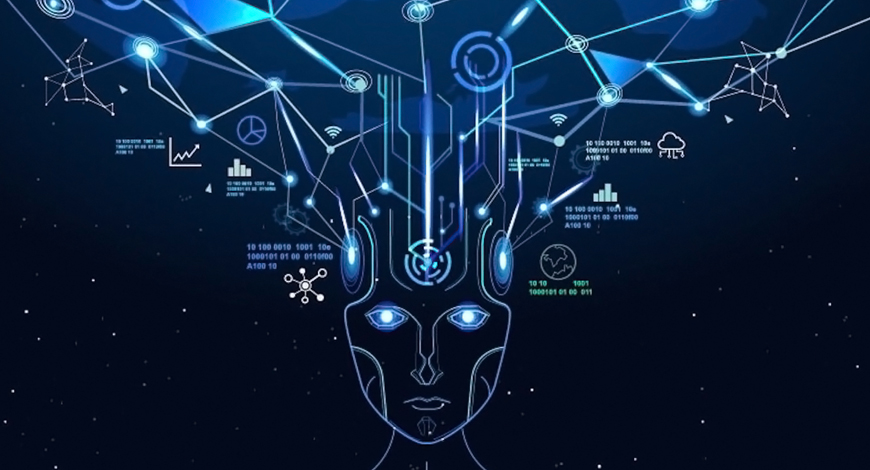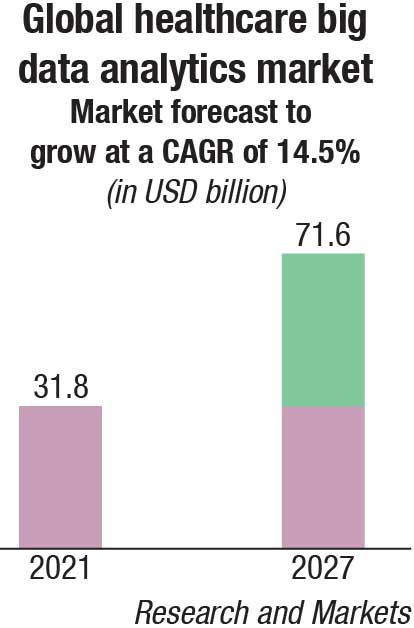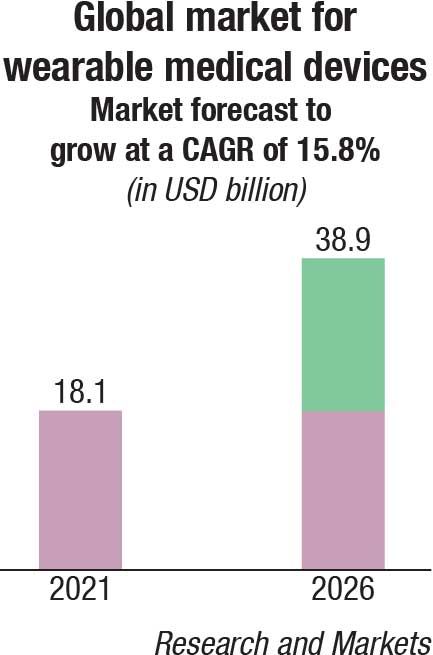Industry
Rethinking and reimagining a technology-infused 2050

“No one can predict what is ahead, but it is safe to assume that we are going to see once-unimaginable healthcare treatments and devices become more available in the coming years.
The pandemic undoubtedly accelerated technological advancement and adoption in healthcare. It is now easier and faster for patients to procure medical services outside of the traditional four walls of the medical establishment, enhancing convenience and accessibility for all.
Telehealth has made it possible for patients to receive care without an in-person office visit. In addition, remote patient monitoring is becoming more widely accepted. Having exponentially grown in popularity throughout the pandemic, this now includes wearable technology with impressive capabilities, from remote monitoring of vitals to remote echocardiograms. If not for the pandemic, it probably would have taken the healthcare industry another decade to reach where it is today.
As an industry, we still have a way to go when it comes to technology, but recent developments have set the industry in a prime position for innovation and improvement. Healthcare technology companies have a massive opportunity to introduce the right tools to help both patients and providers.
In the future of health, expect five key areas – Big data, biometrics, and the internet of things (IoT); machine learning, AI, and advanced analytics; climate change and environmental health hazards; internals, robotics, nanorobotics, and bionics; and genetic engineering and bioprinting – to collectively transform the existing health system from treatment-based reactionary care to prevention and well-being. The traditional boundaries of the industry will dissolve, and new roles will emerge in the future of health as exponential innovation propels the industry toward 2050.
Big data and personalized healthcare. If we could give every individual the right amount of nourishment and exercise, not too little and not too much, we would have found the safest way to health. These words were uttered by Hippocrates, one of the most influential figures in the field of medicine. Today, this reasoning is the very foundation of self-care and health monitoring, something that is getting easier with time.

This is due in no small part to the explosion in wearable technology, coupled with the growth of wireless internet connections. From apps on your smartphone to fitness-tracking devices, people are able to measure their heart rate, blood pressure, eating habits, the number of calories they have burned, and the number of steps they have taken in a day.
By mid-century, this trend will have become the norm for most of the world as internet access becomes near-universal. According to a 2018 report by the UN’s International Telecommunication Union (ITU), 90 percent of the world’s population (estimated to be 9.73 billion people in 2050) will have access to internet services by 2050, whereas somewhere over 4 billion people have access today (out of an estimated 7.9 billion).
In addition to more than four billion new users, the number of wireless devices connected to the internet will increase exponentially by 2050. Between 2016 and 2021, the number of devices connected to a wireless local area network (WLAN) rose from 8.36 to 22.2 billion (or by 265 percent). By mid-century, this number is projected to reach over 100 billion.
Combined with the hundreds of billions of cameras, sensors, homes, and entire cities that will be connected, the resulting explosion in data will create what is known as the IoT. The resulting amount of data produced on a daily basis will be enormous, and a sizeable portion will be medical in nature.
In future smart homes, all of this data will be at a person’s fingertips. As soon as they wake up, health diagnostics and/or recommendations will be available. People will be told how they are doing in terms of achieving or maintaining certain health goals. And if there is a problem, they will be alerted and told to notify their doctor immediately – or perhaps, their doctor will be automatically notified.
AI-assisted medicine. With the massive volumes of medical data health authorities and practitioners will have to contend with, advanced analytics and machine learning (aka AI) will be relied on to monitor it all. On the more localized end of things, AI will be used to analyze patient data for signs of possible health conditions and predict future ones. This will give healthcare practitioners the ability to detect problems in advance and diagnose cases with greater speed and efficiency (and with less risk of misdiagnosis). Patient histories will also be much more up-to-date and detailed, and real-time patient monitoring will be readily available for the elderly and people who are at-risk for stroke, heart attack, etc.
On the macro end of things, AIs will also be responsible for analyzing worldwide health patterns to track pandemics and the spread of disease. The ability to track disease vectors and anticipate mutations in existing viruses will be all the more important as climate change leads to an increase in the spread of deadly viruses worldwide.
Last, but hardly least, AI-assisted research will lead to the development of new treatments and cures for diseases. Ordinarily, producing new drugs and vaccines is a cost-intensive and time-consuming process that involves a lot of experimentation, which is why major pharmaceutical companies are already turning to AI platforms to aid in drug discovery.
As these platforms become more sophisticated and advanced, the development process will become much more rapid and cost-effective. Even before 2050 arrives, vaccines for HIV, some types of cancer, and malaria are expected, meaning they could be joining smallpox on the list of eradicated diseases.
Environmental threats. Between now and 2050, one of the greatest threats facing the global population is the way climate change will affect the social and environmental determinants of health. These include air quality, drinking water, food security, and shelter, all of which will be compromised to an extent by increases in global temperature, flooding, extreme weather, and drought.
For starters, rising temperatures will lead to an increased risk of diseases like Lyme disease, Zika, West Nile, Ebola, dengue fever, and other warm-weather viruses spreading to cooler regions of the world. Similarly, the growth of cities and urban populations will mean an increased risk of respiratory and cardiovascular disease.
According to World Population Prospects, a report compiled by the UN Department of Economic and Social Affairs, by 2050 about 68 percent of the world’s population (6.6 billion people) will live in urban areas (compared to 55 percent today). With increases in temperature, disease, resource depletion, and rising sea levels, people in urban centers will be subject to multiple health hazards.
In rural areas, increased drought, extreme weather, and disease will have a major impact on food security and the agricultural industry. All told, the vulnerable populations will include those living on small islands, coastal regions, megacities, and in mountainous and Polar Regions.
However, the most vulnerable people will be those in the developing world, particularly children and the elderly.
In fact, the WHO anticipates that between 2030 and 2050, climate change will cause approximately 250,000 additional deaths per year. Of these, an estimated 38,000 will be elderly people who die from heat exposure, 48,000 will be due to dysentery (predominantly caused by tainted drinking water), 60,000 will be due to malaria, and 95,000 will be due to childhood undernutrition.
Mitigating the impact this will have on human populations will require international cooperation and multilateral efforts to resettle migrants, distribute medicine and medical services, and build the necessary infrastructure to deal with the crisis.
Mental illness is the new pandemic. While many fatal and degenerative diseases will be (or will be well on their way to being) eliminated by 2050, other ailments will arise to take their place. And whereas improvements in medicine and drug delivery will extend average lifespans, environmental issues will lead to elevated levels of health issues and threats.
By the 2030s, depression and mental illness are expected to overtake heart disease to become the greatest health concern worldwide. Contributing factors will include debt, unemployment, domestic violence, war, the stresses of living in an urban environment, environmental degradation, and disasters.
Changing demographics will also play a role, specifically where age is concerned. According to WHO, between 2015 and 2050, the proportion of the world’s population aged 60 or older will nearly double – from about 900 million to 2 billion (12 percent to 20 percent). Of these individuals, approximately 20 percent will suffer from a cognitive disorder (dementia, Alzheimer’s, Parkinson’s, etc.)
From wearables to internals. Health monitoring is also expected to advance by leaps and bounds as embedded electronics (aka internals) become commercially available. These will consist of flexible electronic patches that can be grafted directly to muscles and organs to monitor heart rate, liver function, kidney function, digestion, respiration, and brain activity for signs of irregularities.

These same devices could also release medication as needed, which would be especially helpful for patients suffering from diabetes or neurological disorders. Between internal sensors that provide regular health monitoring and those that can administer medications, people will be able to personalize their healthcare in a way that was never before possible.
While these devices will assist in the rise of personalized medicine, they are sure to become a regular feature in hospitals as well. Rather than monitoring patients’ vital signs and biometrics with pads that connect via wires to bulky equipment, everything doctors and nurses need to know will be transmitted wirelessly from wearable sensors directly to a patient-monitoring system.
Internals will also take the form of nanomachines, tiny robots that measure only a few microns in diameter – or ~4×10-5 inches (1×10-6 meters). Between 2009 and 2025, the global market value for nanomedicine is projected to grow from USD 53 billion to USD 334 billion – an average of 17.5 percent growth per year. At this rate of increase, the market will be valued at over USD 19 trillion by 2050.
Nanomedicine will come in many forms by mid-century, including nanosensors, nanoparticles, and nanorobots. Nanosensors will take the form of tiny machines equipped with miniscule radio/microwave emitters, and/or spectrometers. These will be taken internally and scan the user’s blood and soft tissue for signs of chemical imbalances, bacteria, viruses, HIV, or cancer cells.
For years, nanoparticles have been investigated for their potential medical applications, and are likely to become the predominant means of medication delivery in the coming years.
For instance, nanoparticles containing bee venom have been proven to be very effective at killing cancer and HIV cells, while leaving surrounding tissue unharmed.
In this respect, medical nanoparticles could cure fatal diseases without the harmful side effects typical of chemotherapy or antiviral drugs.
Meanwhile, nanorobots could be fashioned that would be introduced into the bloodstream and tasked with clearing plaque and blockages from arteries, improving circulation, repairing ulcers, aneurysm, and other health issues.
Employed by hospitals and emergency medical teams (EMTs), medical nanorobots could eliminate the need for exploratory surgery and the old-fashioned diagnostic approach. Simply inject a patient with a culture of nanorobots, and doctors or first responders will have all the data they need to administer life-saving treatment.
Virtual checkups and doctors. Thanks to the growth of broadband internet access, it is also possible that doctors and patients will not even need to meet in person by the mid-century. While face-to-face consultations will still exist, and will be the preferred method in serious cases, teleconsultations will replace regular checkups to a large extent.
Using their household sensors, wearables, and internals, patients could simply send their healthcare data to a doctor who would interpret it (possibly with help from an AI) and dispatch medical advice in return.
Over time, these consultations will likely become more sophisticated, moving from a reliance on devices and apps like Skype or Zoom, to eventually include the use of immersive virtual reality.
When paired with advancements in machine learning and AI, patients may not even need a flesh-and-blood doctor to dispense advice at all. In fact, more people worldwide may entrust their health information to an artificial intelligence (a virtual practitioner, or VP) who will let them know what could be wrong, based on their symptoms.
With advancements in robotics, sensory feedback (aka haptics), and virtual reality, doctors will also be able to perform surgery on patients halfway around the world – teleoperations. While robotic surgery suites, connected to the internet, will perform the actual operations, it will likely be the job of a human surgeon (using a full-body VR suit) to control the procedure.
Robotics and bionics. Advances in robotics and bionics will also be at the forefront of medical innovation as 2050 approaches.
Robotics and cybernetics will become a regular feature for soldiers by 2050 – both on and off the battlefield. But it will be the commercial market where these advancements will be most impactful, particularly for patients recovering from severe accidents and injuries.
Another major innovation is neural implants, which are expected to become commonplace by the mid-century. In addition to enabling brain-to-machine and brain-to-brain interfacing (BMI and BBI), soft and flexible implants could also be used to address brain injuries and cure neurological diseases.
There is also the burgeoning field of bionics, where electronics mimic biology in order to enhance human abilities. While elective and military enhancements are inevitable, medical applications – like artificial organs and replacement limbs – will arguably be the most common by 2050.
Gene editing and bioprinting. In the coming decades, improvements in genome editing are expected to lead to drag-and-drop genetic engineering and the elimination of many genetic diseases.
Meanwhile, gene therapies are anticipated to become commercially available that will be able to restore sight and hearing loss, and cure Alzheimer’s, Parkinson’s, paralysis, and other conditions and degenerative diseases.
As bioprinting becomes more readily available, it will be possible for people to walk into a clinic or hospital, provide a DNA sample, and have a culture of stem cells based on their genome prepared in no time. These stem cells could then be used to fashion whatever the person needs, be it a new kidney, a skin graft, or new blood vessels.
The largest challenge the healthcare industry faces when it comes to adopting new technology is the initial error rate. Generally, new technological products require iteration before they are sufficiently reliable. This iterative process can be painful, potentially resulting in inaccurate predictions and inappropriate recommendations. To avoid this, technologists and clinicians must closely collaborate when rolling out new technology. Together, they will need to carefully test new tools and identify fail-safe methods until reliability is sufficiently achieved.
Harnessing the power of technology and mobility. It is evident that now is the time for healthcare technology companies to instill true, lasting change that will improve the industry for patients and providers nationwide.
This change will be made possible by the continued adoption of innovative technology combined with the rise of a mobile workforce. With certain medical employees not bound by a central physical location, more services can be given outside of the traditional medical establishment – including in a patient’s neighborhood or home.
Looking ahead, it is essential that the healthcare industry remains focused on one common goal – ensuring that everyone, no matter personal circumstances, has access to high-quality and highly affordable care. Advanced technology, made even more powerful by increased mobility, will make this a reality.












